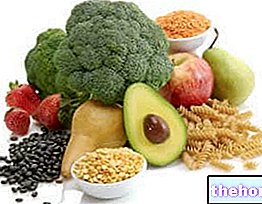Premise
The following indications are for informational purposes EXCLUSIVELY and are not intended to replace the opinion of professionals such as a doctor, nutritionist or dietician, whose intervention is necessary for the prescription and composition of PERSONALIZED food therapies.

High-protein diet
The high-protein diet is a diet based on the extraordinary increase in proteins at the expense of the carbohydrate fraction and, to a lesser extent, of fats.
The term "high protein" is generic, since - considering what is mentioned by the LARN (Recommended Nutrient Intake Levels for the Italian population - SINU) - for the adult subject, protein coefficients higher than 0.75-0.8 g / kg of weight they are already EXCESSIVE and SUFFICIENT to define a HYPERPROTEIC diet; the fact remains that, for various reasons (such as intense sport or chronic malabsorption), it is possible to increase the protein coefficient in the diet up to double the basic recommendations (but not more!) without incurring the risk of exceed the urinary excretion of calcium, as the first drawback of common high-protein diets (Committee for Nutrition and Health of the Nutrition Board of the NRC USA - NRC, 1989). On the other hand, protein levels of 98g / day (> the Italian average) can already be correlated with an increase in urinary calcium excretion (Saba et al., 1990).
To be honest, it is very rare that a diet (albeit calibrated) uses protein values of 0.75g / kg since, being almost "ubiquitous" macronutrients in foods, their contribution also derives from the sum of low and medium value peptides organic (legumes, cereals, vegetables, mushrooms and fruit). In my opinion, a coefficient of 1.2g / kg of PHYSIOLOGICAL weight (always corrected on the basis of "muscle size) is a good compromise between" recommendations "and" practicability of the diet ".
Logically, the term high protein "should" be associated with a diet that provides more than 1.5g / kg of physiological weight desirable in adults, including the risk of urinary excretion of blood and bone calcium. We also remember that high protein diets :
- They increase the processes of deamination and hepatic transamination
- They increase the urea cycle processes
- They increase the renal filtration processes
therefore, they are potentially responsible for long-term hepato-renal overload; nevertheless, since this is a decompensation difficult to find in young adults, this aspect is often underestimated and considered as a form of "nutritional delirium" belonging to the old nutritional school.
NB: Again for ethical correctness, we remind you that in addition to high-protein, even diets excessively low calorie and unbalanced, intense and prolonged sport NOT adequately supported with nutrition And fasts they have the same effects as the hyperproteic diet due to the hyperactivation of neoglucogenesis, considerably depleting the skeletal muscle tissue.
The high-protein diet is also a potentially acidic diet, which favors the lowering of blood pH and requires the intervention of organic buffer systems, therefore, a useful dietary precaution would be to ensure good doses of magnesium and other alkalizing mineral salts.
Except for the estimate of the peptide share, there are no other essential considerations regarding the composition of the high-protein diet; we only remember that it can be used both for weight loss and, in association with the increase of carbohydrates and fats, for the increase of body mass.
NB. The high-protein diet, albeit low in carbohydrates, is to be considered potentially ketogenic; this feature further worsens the tendency to metabolic acidosis and furthermore favors body dehydration with loss of numerous electrolytes.
Useful supplements in case of a high-protein diet
The high-protein diet, if properly managed, does not require any dietary supplement; however, in cases where the organization of meals is particularly problematic, the following may be useful:
- Protein supplements: protein powder (whey, casein, soy, egg), gainer and protein bars; with these products the achievement of the daily protein quota is facilitated with the advantage of shelf life and portability.
- Supplements of branched or essential amino acids: if well contextualized, they can favor the achievement of the plastic requirement at lower doses, thus limiting liver and kidney overload. The branched ones have a good anti-catabolic function, especially in association with maltodextrin to be taken before, during and immediately after training.
- Purifying herbal teas for the liver, as long as they are not excessively draining: some herbal teas can promote the purification of suffering liver cells; a classic example is the herbal tea based on: cumin, turmeric, milk thistle, dandelion and mint. It would therefore be advisable to associate such products with high-protein diets, making sure that, in the case of ketosis, this does not favor dehydration and worsens the electrolyte imbalance.
Example
- Elderly sedentary gentleman, slightly overweight, who has undergone partial bowel resection surgery and has clear symptoms of malnutrition, most likely attributable to post-operative malabsorption.
* We have chosen NOT to administer a low calorie despite being overweight for 2 reasons:
- The presence of malnutrition, which must first be compensated for
- The need for the elderly to preserve a modest adipose layer as it is conservative towards injuries of a traumatic nature.
ATTENTION! By virtue of the foregoing on the effects of the high-protein diet towards urinary excretion of calcium, it is necessary to specify that, in this specific example, the protein fraction (even if it is> 98g / day) should compensate for the limitations of intestinal absorption and, therefore , would not be excessive; however, considering the age of the subject and the relative tendency to lose bone mass, it is advisable to continue the diet in question ONLY until the state of nutrition is recovered and at a later time supplement the diet of maintenance (characterized by a protein intake not exceeding 1.5g / kg) with essential amino acids in doses of less than or equal to 1g per 10kg of desirable physiological weight.
High Protein Diet Example - Day 1
High Protein Diet Example - Day 2
High Protein Diet Example - Day 3
High Protein Diet Example - Day 4
High Protein Diet Example - Day 5
High Protein Diet Example - Day 6
High Protein Diet Example - Day 7




























